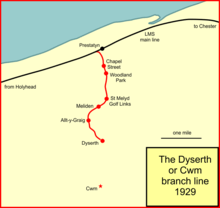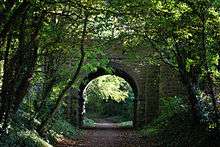Dyserth branch line
Dyserth branch line was a short standard-gauge mineral railway between the northern end of the Clwydian Range at Dyserth and the North Wales Coast Line at Prestatyn.[3] The line, which was opened by the London and North Western Railway in 1869, was built to carry quarried stone and coal. The rise of tourism led to the introduction of a passenger service in 1905. Basic halts were introduced along the line. However, competition from road transport led the passenger service being withdrawn in 1930.[4] With the eventual demise of all the mineral industries around Dyserth the entire line was closed in September 1973.
| Dyserth Branch Line | |
|---|---|
| Overview | |
| Type | Heavy Rail |
| Locale | Prestatyn Denbighshire, Wales |
| Termini | Prestatyn Dyserth |
| Stations | 7 |
| Operation | |
| Opened | 1 September 1869[1] |
| Closed | 7 September 1973[2] |
| Owner | British Railways Previously LNWR then LMSR |
| Character | Rural |
| Technical | |
| Line length | 2 miles 74 chains (4.7 km) |
| Number of tracks | 1 |
| Track gauge | 4 ft 8 1⁄2 in (1,435 mm) standard gauge |
| Minimum radius | 11 chains (220 m) |
| Operating speed | 25 miles per hour (40 km/h) |
| Maximum incline | 1 in 45 |
Planning and construction

The line was connected to the Chester and Holyhead Railway which had opened completely by 1850. Little intermediate business was expected because the primary purpose of the line was to provide a direct connection with the ferries to Ireland at Holyhead, chiefly for Government mails. In 1859, the London and North Western Railway had taken over the Chester and Holyhead Railway.[5]
The area between Dyserth and Cwm was where there was lead and haematite mining as well as numerous limekilns. These heavy industries shipped their ore to the River Clwyd for marine cargo vessels but this soon became disadvantageous compared to other mines and quarries with rail connections. Initial proposal in 1860 was to build a mineral railway directly to Cwm in 1860 but this was never realised[6]. On 16 July 1866 the LNWR obtained Parliamentary authority to build a branch line from its main line at Prestatyn to Dyserth. As part of the proposed work, the movable bridge over the Clwyd carrying the main line was to be improved.
In 1868 the construction of the line began after delays in land acquisition. The line was steeply graded and had sharp curves.[7][6]
History
Freight and mineral
The branch, which was originally known as the known as the Prestatyn and Cwm Line, opened to goods and mineral traffic on 1 September 1869. Shortly afterwards an intermediate goods station at Meliden was opened. Due to the steep gradients, all trains were required to be propelled up the branch (so that the locomotive was always at the lower end of the train). No run-round facility needed to be provided at Dyserth for that reason.[6][8]
After a limestone quarry was opened east of Dyserth, construction began on earthworks for an extension of the line but no track was ever laid.[9]
Apart from short level sections through Meliden and Dyserth stations, the line climbed southwards on a significant gradient, with the steepest stretch at 1 in 45.[10] The sharpest curve had a radius of 11 chains (220 m).[11] These factors combined to necessitate ruling speed limits of 20 mph for trains climbing to Dyserth and 25 mph back to the main line. These limits were lowered to 15 mph over level crossings and 10 mph approaching the junction with the main line. In practice the heavy loads, curves, visibility and gradients confined speeds to around 10 mph throughout.[12]
Passengers
| Dyserth branch line | |||||||||||||||||||||||||||||||||||||||||||||||||||||||||||||||||||||||||||||||||||||||||||||||||||||||||||||||||||||||||||||
|---|---|---|---|---|---|---|---|---|---|---|---|---|---|---|---|---|---|---|---|---|---|---|---|---|---|---|---|---|---|---|---|---|---|---|---|---|---|---|---|---|---|---|---|---|---|---|---|---|---|---|---|---|---|---|---|---|---|---|---|---|---|---|---|---|---|---|---|---|---|---|---|---|---|---|---|---|---|---|---|---|---|---|---|---|---|---|---|---|---|---|---|---|---|---|---|---|---|---|---|---|---|---|---|---|---|---|---|---|---|---|---|---|---|---|---|---|---|---|---|---|---|---|---|---|---|
| |||||||||||||||||||||||||||||||||||||||||||||||||||||||||||||||||||||||||||||||||||||||||||||||||||||||||||||||||||||||||||||
Toward the end of the Victorian era, and in the Edwardian period, tourism developed rapidly, and Dyserth Castle[note 1] and the waterfalls at Cwm became important tourist destinations. In response, the LNWR started a passenger service on the branch from 28 August 1905, using a steam railmotor.[note 2][13] The main line junction for the branch faced away from Prestatyn station, so the branch train ran to the junction and reversed direction there on to the branch.[7][6]
There were two intermediate stations at first, with basic platform accommodation, but as residential development took place, additional halts were provided. In 1919 there were eleven journeys each way, weekdays only.
The railmotors were popular, and from 1911 a trailer car was added to the formation. After 1919 auto-trains[note 3] were brought in to replace the railmotors.[6]
- Timeline
- Prestatyn Junction; branch diverged from Holyhead to Chester line;
- Chapel Street; opened 29 January 1906; closed 22 September 1930;
- Rhuddlan Road; opened 28 August 1905; renamed Woodland Park 1923; closed 22 September 1930;
- St Melyd Golf Links; opened 1 October 1923; closed 22 September 1930;
- Meliden; opened 28 August 1905; closed 22 September 1930;
- Allt-y-Graig; opened 1 February 1929; spelt Alt-y-Craig at first; closed 22 September 1930;
- Dyserth; opened 28 August 1905; closed 22 September 1930.[14]
Decline and closure
Although the train services were popular, road bus services were considered to be much more convenient by the mid 1920s. The last timetabled passenger train ran on 20 September 1930. Two enthusiasts' special trains traversed the line, the "North Wales Rail Tour" where a tank locomotive propelled three coaches to Dyserth on 2 October 1955[15] and "The Welshman" formed of a six car DMU on 11 October 1969.[16][17]
After goods and mineral traffic on the line declined, the branch was closed to general traffic on 1 December 1951, while coal continued to be hauled as the only ordinary traffic; that too ceased on 4 May 1964. A revival in limestone quarrying at Dyserth resulted in continuation of the branch, as a private siding, until 8 September 1973. In 1974, after two special mineral trains were run to remove material at the quarry, the branch was closed completely and the track lifted shortly afterwards[7][18][19]
Remains

Much of the trackbed is now used as a footpath, which retains many historical railway points of interest. There are two pieces of track at Chapel Street, the Woodland Park Bridge, Meliden Goods Shed and Loading Gauge, and an original crane from the Dyserth Railway at the end of the walk.[20]
Notes
- The castle was a ruin; it was later demolished in pursuit of the quarrying operations in the area.
- A self-contained passenger coach incorporating a small steam engine, considered to be an economical way of handling small passenger volumes.
- Conventional locomotives operating with a driving trailer coach, from which the driver could control the locomotive; additional trailers could be incorporated in the formation.
References
- Goodall 1986, p. 11.
- Goodall 1986, p. 76.
- Jowett 1989, Map 56.
- Anderson & Fox 1984, Plates 84 & 86.
- Baughan 1972, p. 177.
- Rear 2003, pp. 47-52.
- Baughan 1981, pp. 79-80.
- Robinson 2018, pp. 749 & 753.
- Green 1996, p. 55.
- Robinson 2018, p. 748.
- Goodall 2003, p. 22.
- Thompson 1985, Plate 11.
- Goodall 2003, pp. 60-64.
- Quick 2019, p. 155.
- Image of ticket Calendariu
- Clemens 2014, 42 mins from start.
- Thompson 1978, pp. 37 & 9.
- Rear 2003, p. 51.
- Mitchell & Smith 2011, Plate 120.
- "Dyserth Railway". Dyserth.
Sources
- Anderson, V. R.; Fox, G. K. (1984). An historical survey of Chester to Holyhead Railway : track layouts and illustrations. Poole: Oxford Publishing Company. ISBN 978-0-86093-216-1.CS1 maint: ref=harv (link)
- Baughan, Peter E (1972). The Chester and Holyhead Railway. 1. Newton Abbot: David and Charles. ISBN 978-0-7153-5617-3.CS1 maint: ref=harv (link)
- Baughan, Peter E (1991). Regional History of the Railways of Great Britain: North and Mid Wales. 11. Nairn: David St John Thomas. ISBN 978-0-946537-59-4.CS1 maint: ref=harv (link)
- Christiansen, Rex (1976). Forgotten Railways: North and Mid Wales. Newton Abbot: David and Charles. ISBN 978-0-7153-7059-9.CS1 maint: ref=harv (link)
- Clemens, Jim (2014) [1959]. Steam to North Wales (DVD). Uffington, Shropshire: B&R Video Productions. Vol 136.CS1 maint: ref=harv (link)
- Goodall, Stephen P. (2003). The Prestatyn and Dyserth Branch Line. Headington: Oakwood Press. ISBN 978-0-85361-313-8. LP 160.CS1 maint: ref=harv (link)
- Green, C.C. (1996) [1983]. North Wales Branch Line Album. Shepperton: Ian Allan Publishing. ISBN 978-0-7110-1252-3.CS1 maint: ref=harv (link)
- Johnson, Peter (1995). North Wales (Celebration of Steam). Shepperton: Ian Allan Publishing. ISBN 978-0-7110-2378-9.CS1 maint: ref=harv (link)
- Jowett, Alan (March 1989). Jowett's Railway Atlas of Great Britain and Ireland: From Pre-Grouping to the Present Day (1st ed.). Sparkford: Patrick Stephens Ltd. ISBN 978-1-85260-086-0. OCLC 22311137.
- Mitchell, Vic; Smith, Keith (2011). Chester to Rhyl, including the Holywell Town and Dyserth Branches. Midland Main Lines. Midhurst: Middleton Press (MD). ISBN 978-1-906008-93-2.CS1 maint: ref=harv (link)
- Quick, Michael (2019) [2001]. Railway passenger stations in Great Britain: a chronology (PDF) (5th ed.). Railway and Canal Historical Society.
- Rear, W.G. (2003). From Chester to Holyhead : The Branch Lines. Shepperton: Ian Allan Publishing. ISBN 978-0-86093-569-8.CS1 maint: ref=harv (link)
- Robinson, Tony (December 2018). Blakemore, Michael (ed.). "The Dyserth Branch". Back Track. Vol. 32 no. 12. Easingwold: Pendragon Publishing.CS1 maint: ref=harv (link)
- Thompson, Trefor (1978). The Prestatyn and Dyserth Railway. Rhuddlan: North Clwyd Railway Association. ISBN 978-0-9506661-0-5. OCLC 11120869.CS1 maint: ref=harv (link)
- Thompson, Trefor (1985). The Prestatyn and Dyserth Railway - A Pictorial History. Rhuddlan: Charter Publications. ISBN 978-0-907157-02-1.CS1 maint: ref=harv (link)
Further reading
- Hitches, Mike (2013). Steam around North Wales. Stroud: Amberley Publishing. ISBN 978-1-4456-0765-8.CS1 maint: ref=harv (link)
- Holland, Julian (2015). Exploring Britain's Lost Railways. Glasgow: Harper Collins. ISBN 978-0-00-794901-4.CS1 maint: ref=harv (link)
- Williams, C.J. (1980). Metal mines of North Wales. Rhuddlan: Charter Publications. ISBN 978-0-907157-00-7.CS1 maint: ref=harv (link)
Mapping
- "The line and its stations". Rail Map Online.
- "The line on old OS maps with modern overlays". National Library of Scotland.
- "The whole line and closed stations on 1940s OS maps". npe Maps.
External links
- Line history Dyserth-Prestatyn Railway
- Dyserth station and line history Disused Stations
- The line and mileages Railway Codes
- Video of a trip along the line in 1968 YouTube
- The northern end of the line and junction with the main line Britain from Above (free login needed to zoom)
- The northern end of the line and junction with the main line Britain from Above (free login needed to zoom)
- The northern end of the line and junction with the main line Britain from Above (free login needed to zoom)